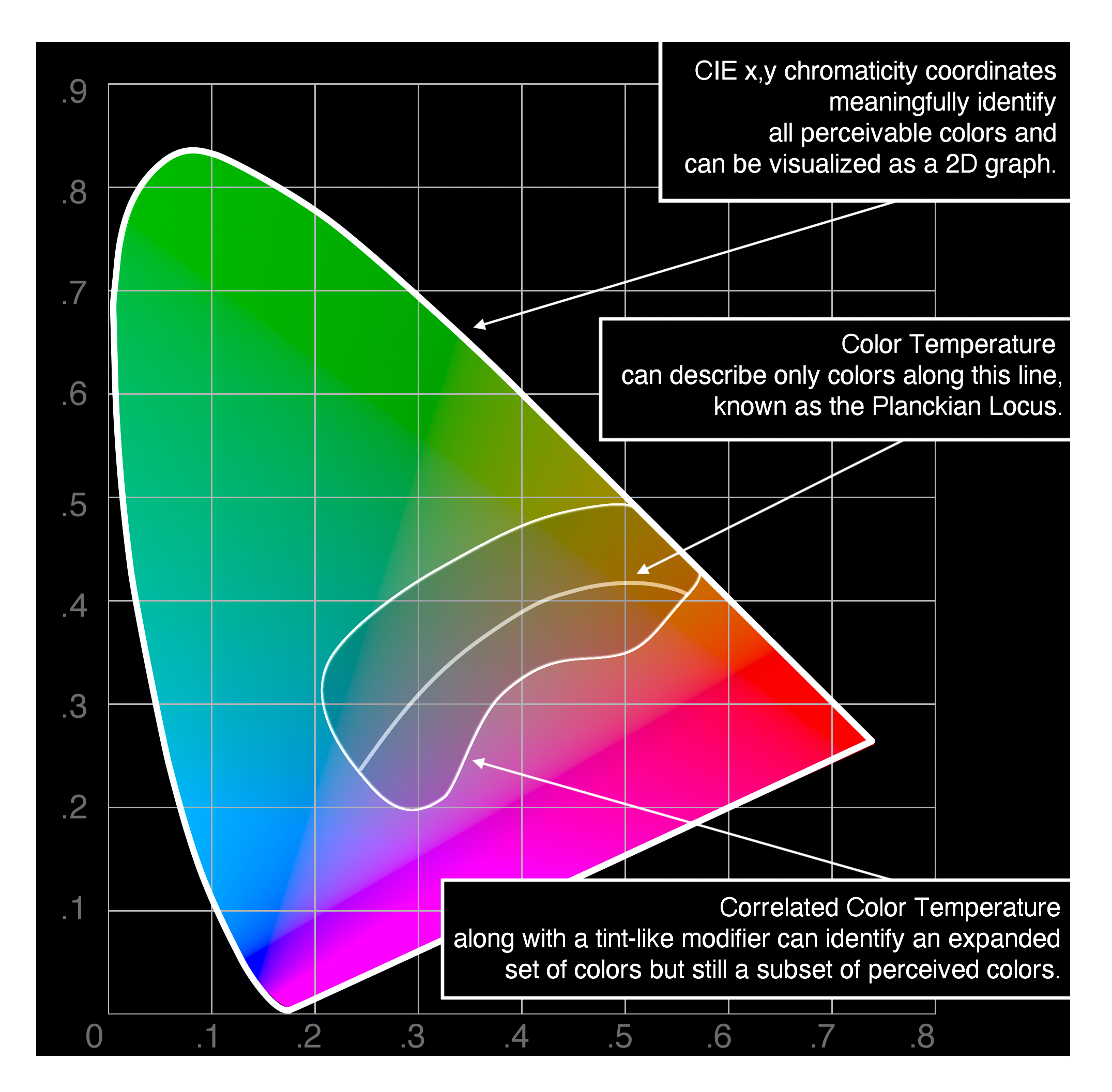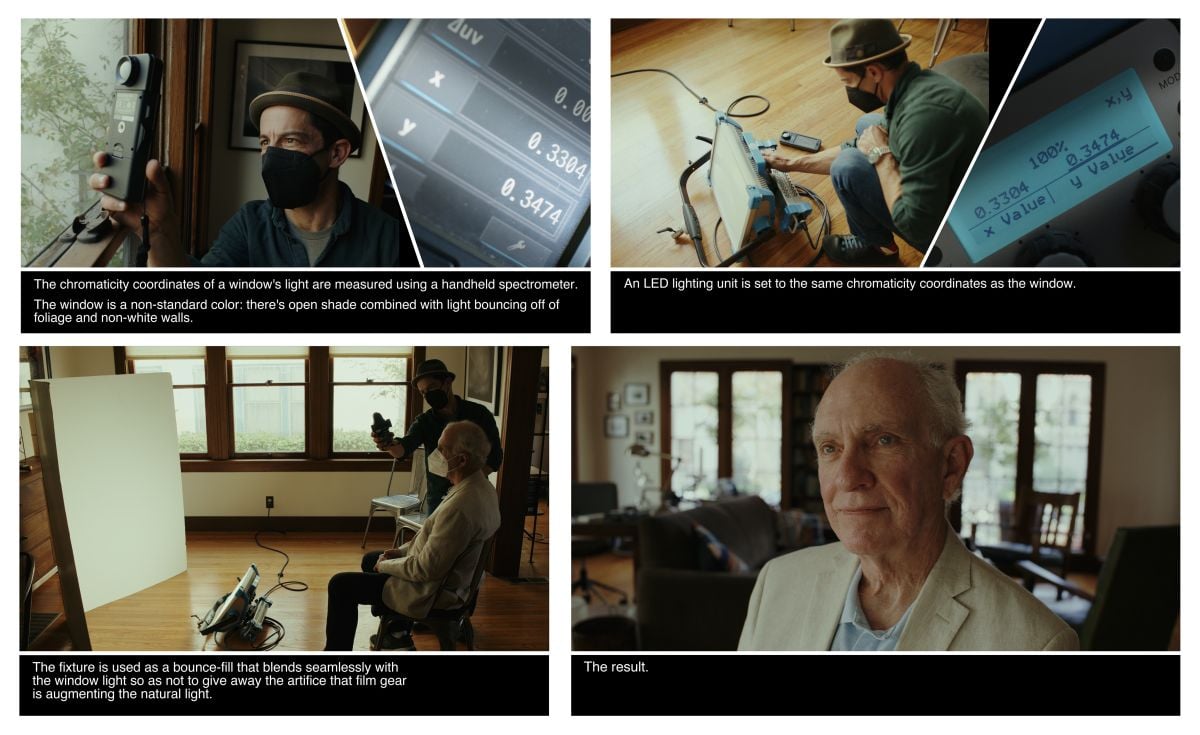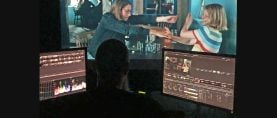
Clear-Cut Color: Communicating Chromaticity in Motion-Picture Production
This brief glimpse is just the beginning of the possibilities. If we as a community are willing to expand our toolsets, the returns can be extraordinary.

By Jaron Presant, ASC
Cinema lighting is currently undergoing exciting innovations in a wave of improving technologies for the on-demand tuning of light color. But as tools become more complex, intricate and varied, we need new solutions for wrangling the sprawling variables — variables that have the potential to give us rich creative control, but too often just leave us in a technical boondoggle.
Imagine that you’re shooting a scene in California, with a September sunset glinting across a coastal Santa Barbara seascape. After shooting the sweeping wide shots on location at the perfect moment, you then need to suspend that sunset indefinitely for a long dialogue portion of the scene that will be shot on a soundstage. To evoke the time and place on stage, you’re after that same unique sunset color you already captured on location. To create this kind of nuance, it’s not sufficient to merely put a standard orange gel over an incandescent lamp or set an LED unit’s menu to a generic “sunset” option.

In pre-LED days, re-creating such a precisely unique color would have been virtually unthinkable. But today, we may search for the answer in the vast array of modes, dials, buttons, options and sliders offered in many contemporary LED fixtures — yet fiddling with a looming pile of opaque and non-standardized knobs is not the goal. Our goal is to light the scene with our be-loved sunset color and not get bogged down in technical minutia. We want to spend our precious time on set making beautiful images, not tediously navigating user menus and manufacturer-specific settings that have no coherent correlation to our artistic intent.
The solution lies not in piling on even more bandages by adding extra dials and knobs, but in clarifying the problem and fixing it at its root. And at the heart of this problem, there indeed lies an issue to be solved before any others: the lack of a workable industry norm for unambiguously identifying color. We need a way to uniquely quantify the singular sunset color that we photographed on location, and then measure whether our lighting equipment onstage is truly creating the same color.
“Could we be on the precipice of a paradigm shift in cinema lighting?”

It may seem like our common practices have this covered, but they don’t. Color temperature is habitually employed, but this method is problematic, as it only describes a small subset of perceivable colors. Additionally, unlike its implementation in hard science where color temperature is rigidly defined, the numeric-sounding color-temp settings in our industry have become descriptive names that don’t have fixed definitions. For example, “3,200K” can mean the color of a traditional cinema incandescent fixture or the hard-science definition of a point on the Planckian locus at 3,200K, yet these are different colors. On top of that, “color temperature” and “correlated color temperature” (CCT) are often used interchangeably, but they are not the same thing. With so many layers of ambiguity, the system breaks down, leaving us with an un-reliable way to identify colors. And if that weren’t enough, because color temperature uses a sliding (logarithmic) scale, equal numeric changes at different Kelvin temperatures aren’t perceptually uniform, which makes the whole system difficult to conceptualize, implement or use with a sense of assured meaning.
Another commonly used color system is RGB, but that method is even more undependable. Not only are there countless RGB color spaces (not to mention each individual LED’s own native RGB), but all RGB color spaces entangle brightness with color, so it’s impossible to identify a color of light without an associated brightness. Additionally, most LED lighting fixtures have R, G and B (red, green and blue) illuminants inside them, but no two models have the same colors of red, green or blue emitters. Add to this that most have one or several other illuminants in addition to red, green and blue, and we are left with a messy, ambiguous conversion to RGB.
“Chromaticity coordinates successfully, precisely and uniquely name colors in a way that none of the other methods can.”

Sounds like chaos, right? Well, here’s the good news: although there is not a widely adopted, workable system in everyday use within the film industry, such a system already exists in the realm of the hard sciences. And it is implemented in the film industry, though it’s not a commonly used methodology. So the solution, at least to the problem at the base of the pile, does not need to be developed from scratch, but merely adopted as common practice.
The solution is this: chromaticity coordinates. And indeed, chromaticity coordinates successfully, precisely and uniquely name colors in a way that none of the other methods can.
The study of color in academia and hard science has long established methods for evaluating a flow of light in the physical world, and correlating with how an observer — whether it’s a person, an image sensor or a film emulsion — will perceive that barrage of photons as a color. The results of this correlation can be represented using a two-dimensional coordinate system — that is, by representing each distinct perceived color as a location (a coordinate) on a flat graph.
There are several (inter-convertible) metrics for this method of identifying and distinguishing all perceived colors using chromaticity coordinates. The most apt for our purposes is a color space called “CIE 1931 xyY,” or “x,y” for short. Perhaps you’ve seen this graph, but not heard it described in quite this way.
This is the key: We need to change our industry paradigm for identifying colors of light, from methods that simply pose as rigorous to a method that is actually numeric, unambiguous and thorough. That method is chromaticity coordinates.
Once we’ve laid this foundation, vast creative possibilities emerge, while technical quagmires fall away. And we can build on these underpinnings to go beyond merely matching and re-creating colors. It now becomes possible to find various blends and equivalents that allow for so much more functionality. We can meaningfully control fixtures that don’t have built-in x,y modes, or find creative new color blends without a physical reference. Beyond matching our Santa Barbara sunset, we can re-create it at half of its saturation, or figure out which color to set our light to if we want that same color under a different white balance. We can even determine whether an unexpected result is due to a spectral sensitivity issue. The possibilities go on and on.
Could we be on the precipice of a paradigm shift in cinema lighting? What I’m proposing is a modest first step, but once the ball gets rolling, filmmakers and manufacturers can start inspiring each other with ideas, building positive feedback loops that will produce exciting opportunities. Imagine what the future could hold. As x,y becomes more common, we would gain a common reference point — a shared language to precisely communicate exact colors. And with precise language comes precise control that leads to the ultimate goal: greater authorship of our images.
This brief glimpse is just the beginning of the possibilities. If we as a community are willing to expand our toolsets, the returns can be extraordinary.
Jaron Presant became a member of the ASC in 2018.






